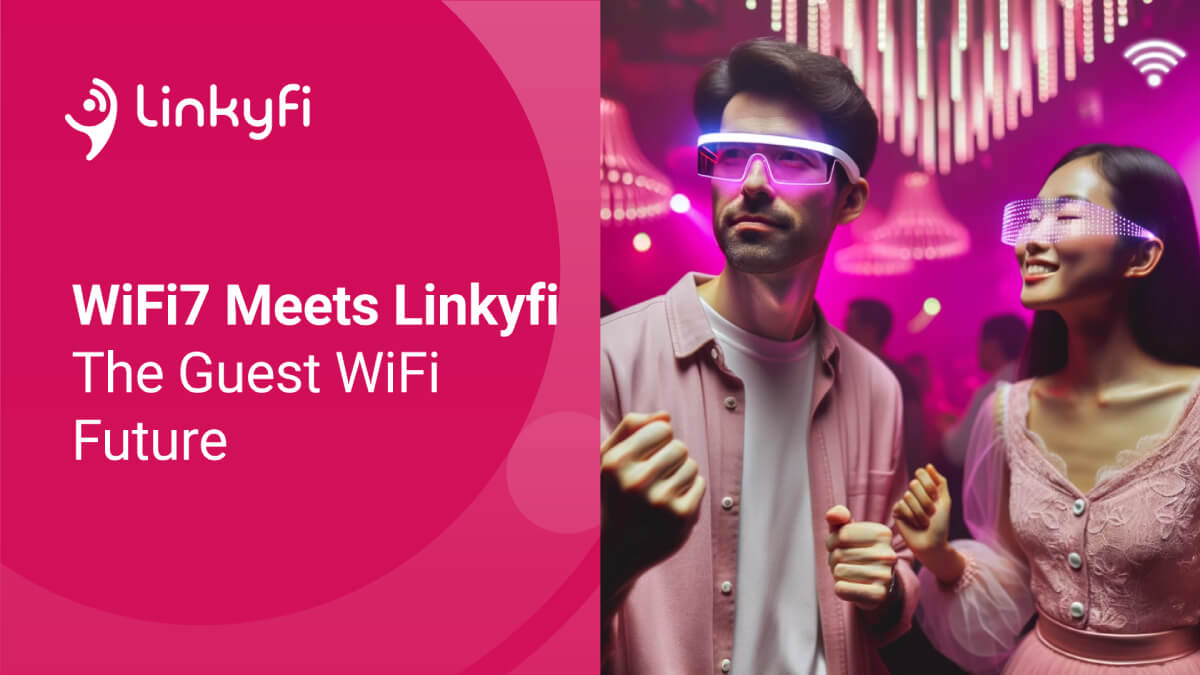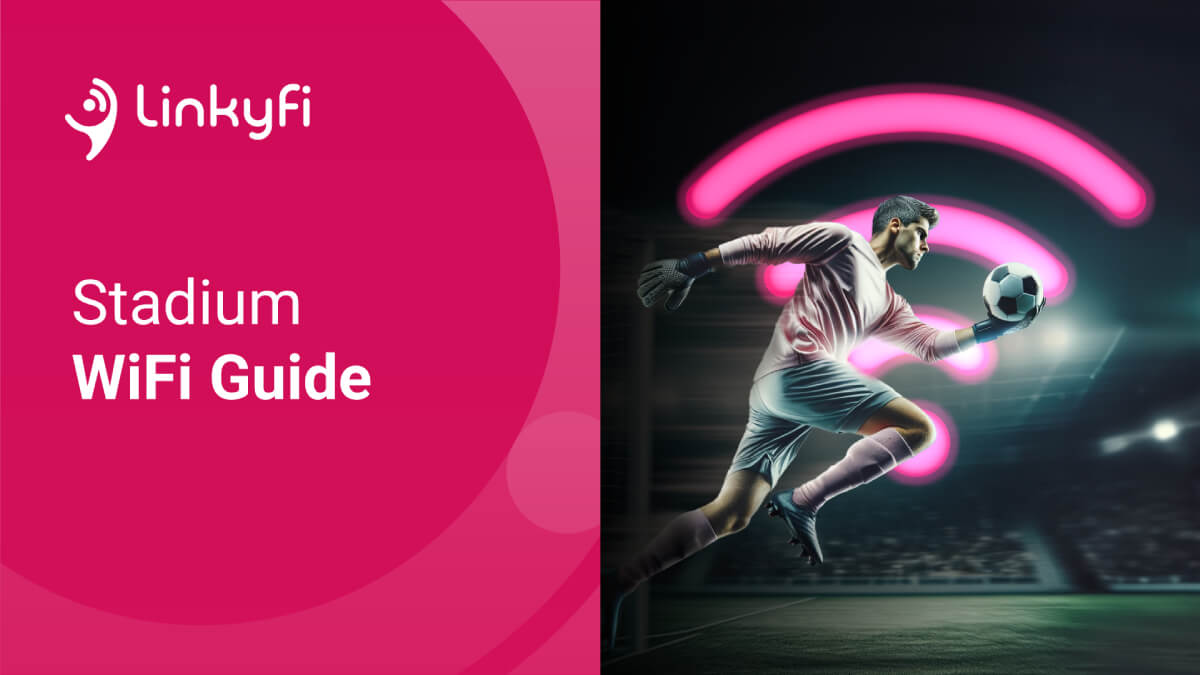WiFi7 Meets Linkyfi - The Guest WiFi Future

That Awkward Moment When Your AR Glasses Fail Mid-Dance Move...
Picture this: You're at the hottest club in town, rocking those sleek AR glasses - connected to guest WiFi. The rhythm takes over, and as you're about to break into your signature move, your glasses overlay freezes. The AR app that was showing you those rad dance moves suddenly stops. The horror, right? Have you ever faced this?
Of course not! But fast forward a few years, and this could be your Friday night nightmare. Unless... enter WiFi 7 and the Linkyfi guest WiFi marketing platform.
Now that we've got your attention (and possibly ignited a tiny fear about future dance floor embarrassments), let's shimmy our way through the world of WiFi 7 or in more geeky words IEEE 802.11be . And trust us, this tech jig is both groovy and geeky!
Why wait? Dive into the digital future with Linkyfi's expertise now!
Latency: The Unsung Hero
With the prowess of WiFi7, not only can we expect latency to be a mere 5ms in the most challenging scenarios, but the potential for implementing Time-Sensitive Networking (TSN) also becomes a promising possibility.

Everyday AR Shopping
Imagine walking through your local supermarket, wearing a pair of AR glasses. As you stroll the aisles, these glasses overlay real-time product information, reviews, and even virtual cooking demonstrations – all without a hint of lag. With the latency improvements in WiFi7, AR shopping becomes not just a novelty but a seamless, integrated experience. Price comparisons, product sourcing, and even augmented reality fitting rooms in apparel stores become instantaneous, enhancing the shopping experience for everyday users.
Industry 4.0: The Future Factory Floor
Moving from retail to manufacturing, the latency leaps in WiFi7 play a pivotal role in Industry 4.0. In smart factories, where real-time data is king, reduced latency ensures machinery, IoT devices, and analytics platforms communicate in near real-time. Whether it's a robotic arm needing immediate feedback from sensors or AI-driven quality control systems analyzing products on the assembly line, the low latency of WiFi7 ensures operations are efficient, accurate, and responsive. In an era where milliseconds can mean the difference between optimum output and costly downtime, WiFi7's latency advancements are nothing short of revolutionary.
Gaming: Where Every Millisecond Counts
And now, to the realm where latency has been the arch-nemesis for years: gaming. In the world of online multiplayer games, latency can mean the difference between victory and defeat. With WiFi7, gamers can bid farewell to frustrating lags and missed opportunities. Whether you're in a high-stakes first-person shooter match or an intricate strategy game, WiFi7 ensures your moves are transmitted in real-time, giving you the edge over competitors. For professional gamers and casual players alike, this leap in latency reduction is a game-changer (pun intended).
Frequency Bands: The Ultimate Trio
WiFi7 operates across three primary frequency bands, each presenting its unique advantages and challenges. However, it's crucial to note that the availability and exact specifications of these bands can vary based on country regulations. Here's a breakdown of the pros and cons for these bands.
2.4GHz Band
Pros:
- Broad Coverage: The 2.4GHz band can cover larger areas, making it suitable for wider spaces.
- Penetration: This frequency can better penetrate through walls and solid objects, ensuring connectivity even in challenging environments.
Cons:
- Potential Interference: Given its widespread usage, this band is prone to interference from a multitude of devices.
- Lower Data Rates: Compared to higher frequencies, the 2.4GHz band generally offers slower data speeds.
5GHz Band
Pros:
- Faster Data Rates: The 5GHz band can provide quicker data transfer rates, ideal for high-bandwidth activities.
- Less Interference: With a broader spectrum, it experiences reduced congestion and interference compared to the 2.4GHz band.
6GHz Band
Pros:
- Increased Bandwidth: The 6GHz band offers even more bandwidth, paving the way for ultra-fast connections.
- Minimal Congestion: As a newer spectrum, fewer devices operate on it, resulting in reduced interference and congestion.
Cons:
- Shorter Effective Range: Like the 5GHz, the 6GHz band has a limited effective range.
- Challenges in Penetration: Its ability to penetrate through physical barriers is similar to the 5GHz, facing difficulties with walls and solid objects.
With these bands in play, WiFi7 is equipped to cater to a myriad of connectivity needs, from vast open spaces to data-intensive applications in compact areas.

Interferences
Thanks to WiFi 7's capability of partial usage of bands, called MRU - Multi Resource Units, in the face of interference, disturbances like other electronic devices won't stand a chance. The channel can be divided into 78.125kHz subcarriers and use only part of them. Your AR experience remains uninterrupted, even if somewhere in the club, someone's trying to microwave a burrito.
Seeking WiFi wisdom? Connect with Linkyfi's pros!
4096 QAM OFDMA & 16x16 MU-MIMO: Geeky Terms That Make All the Difference

4096 QAM (Quadrature Amplitude Modulation)
QAM is a modulation technique that conveys data by changing the amplitude of two carrier waves. The "4096" in 4096 QAM indicates the number of unique amplitude combinations the modulation can use to represent data. Essentially, with 4096 different combinations, more data can be transferred in each transmission, allowing for faster data rates without requiring additional bandwidth.
Comparing to 1024 QAM in WiFi 6 it’s 20% improvement, why 20% because it’s 12 bits (2^10 = 4096) in one symbol in place of 10 bits (2^10 = 1024)
OFDMA (Orthogonal Frequency Division Multiple Access)
OFDMA is a method wherein a single transmission channel is divided into multiple smaller sub-channels or subcarriers. These subcarriers can carry data independently, permitting several users to transmit data at the same time on the same channel. By using orthogonal frequencies, OFDMA ensures that these sub-channels do not interfere with each other, allowing for efficient and simultaneous data transmission from multiple users.
16x16 MU-MIMO (Multi-User, Multiple Input, Multiple Output)
MU-MIMO is a technology that lets a WiFi router communicate with multiple devices simultaneously rather than sequentially. The "16x16" denotes the router's capability to interact with up to 16 devices both for sending and receiving data at the same time. This means that instead of devices waiting in a queue for their turn to communicate with the router, they can all interact concurrently, optimizing network traffic flow and efficiency.
Ride the WiFi 7 wave. Join Linkyfi!
Aren't We Forgetting Someone? Oh Right, Guest WiFi!
With the advent of WiFi 7, the potentials of Guest WiFi have been magnified, but when combined with platforms like Linkyfi, these potentials hit a new zenith. Linkyfi, with its built-in location engine and marketing campaign capabilities, supercharges the WiFi 7 experience in commercial venues. Here's how:
Smart Retail Experiences: Through Linkyfi's platform, retailers can offer WiFi 7-powered Guest WiFi to shoppers. As they saunter in, donning their snazzy AR glasses, the location engine is on the prowl, pinpointing their exact position. And bam! Proximity hyper-local notifications pop up right in their field of view, dishing out real-time, personalized offers based on shopping history or even the exact aisle they're currently contemplating a purchase in. So, whether they're eyeing those snappy sneakers or pondering over pastries, tailored deals and suggestions are served on a virtual platter. It's not just shopping; it's a futuristic retail rendezvous, all thanks to the seamless blend of high-speed connectivity, location-based services, and AR magic.
Interactive Museums & Exhibits: Museums equipped with Linkyfi can offer augmented reality (AR) tours, perfect with its location engine. As visitors move from one exhibit to another, they receive rich, immersive insights streamed seamlessly due to WiFi 7's low latency. This union makes learning interactive and engaging.
Transport Hubs: Airports and train stations with Linkyfi can push real-time journey updates to travelers. As travelers move from one terminal to another, AR navigation aids, powered by the location engine, guide them, ensuring a seamless transit experience. Delays, gate changes, and other crucial information are delivered precisely when and where needed.
Hospitality and Resorts: Hotels can elevate their guest experience by integrating Linkyfi with their Guest WiFi. As guests roam the hotel, they can receive real-time offers for spa appointments, dinner reservations, or events. The built-in location engine can even guide them to these amenities, ensuring they make the most of their stay.
By synergizing the capabilities of WiFi 7 with Linkyfi's guest WiFi platform, commercial venues can not only offer robust connectivity but also create enriched, personalized, and dynamic experiences for their patrons.
Chat with Linkyfi's team now!
Conclusion
As we peer into the digital horizon, the fusion of WiFi 7's unparalleled speed with the adaptability of guest WiFi emerges as a game-changer. This powerful combination doesn't merely connect us; it paves the path for a tailored, futuristic experience. Truly, the beacon for tomorrow's connectivity has been lit.
Experience counts. Dive into Linkyfi's expertise now!
Recommended posts
- Understanding WiFi Access Points: A Simple Guide
- WiFi for Stadiums Explained
- Guest WiFi - Easter Marketing with AI: A Step-by-Step Guide
Subscribe to stay in the loop with all our latest content:
Recommended posts



